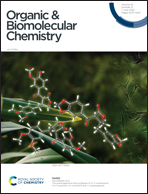Acid responsiveness of emissive morpholinyl aminoquinolines and their use for cell fluorescence imaging†
Abstract
Herein, we report emissive aminoquinoline derivatives (TFMAQ) containing alkylmorpholine and arylmorpholine groups and their photophysical properties, acid-responsiveness, and organelle targeting. The alkylmorpholine group is well-known to favour accumulation in lysosomes and be acid-responsive, but, counterintuitively, the TFMAQ derivatives containing ethylmorpholine groups showed limited accumulation in lysosomes and, instead, preferential accumulation in lipid droplets. The findings reported here will aid the development of organelle/tissue specific dyes for cell imaging and diagnosis.



 Please wait while we load your content...
Please wait while we load your content...